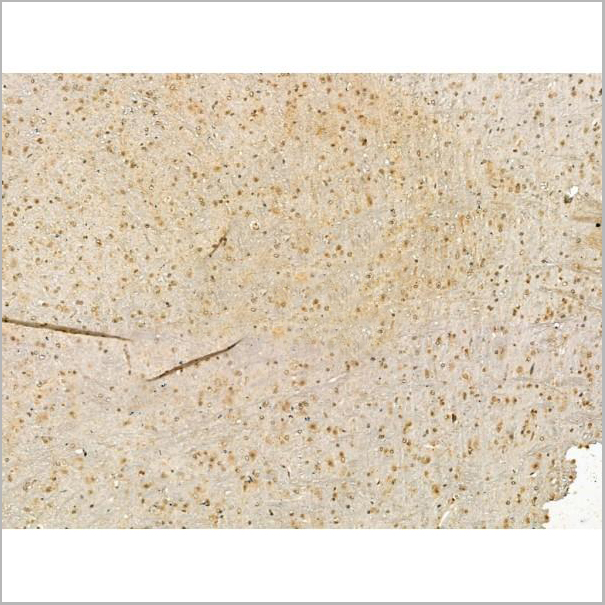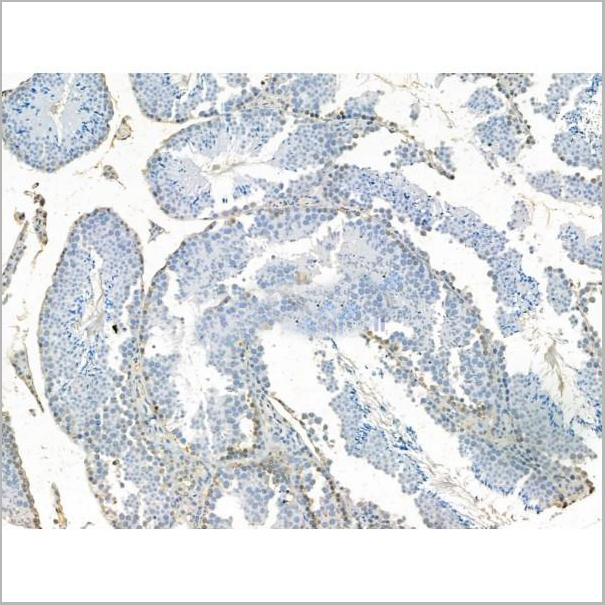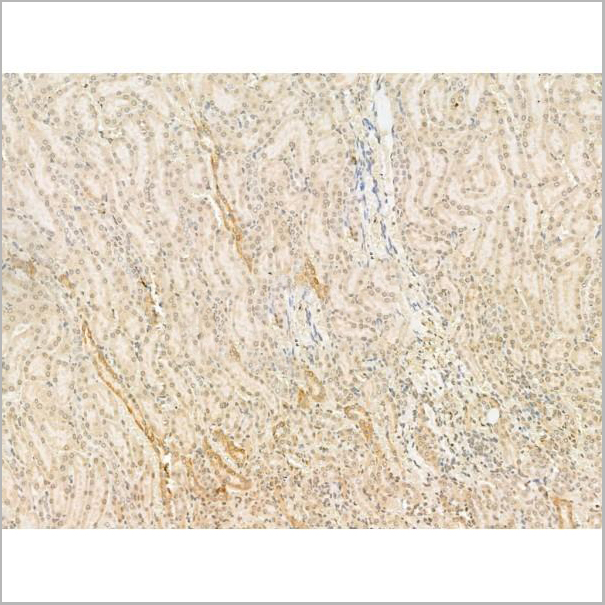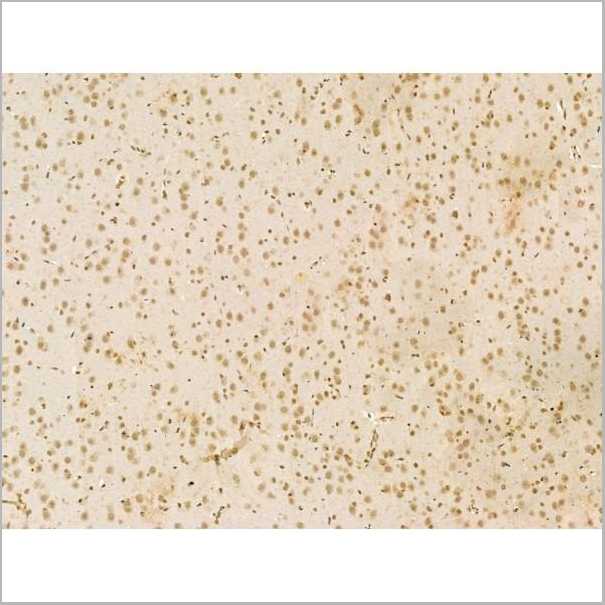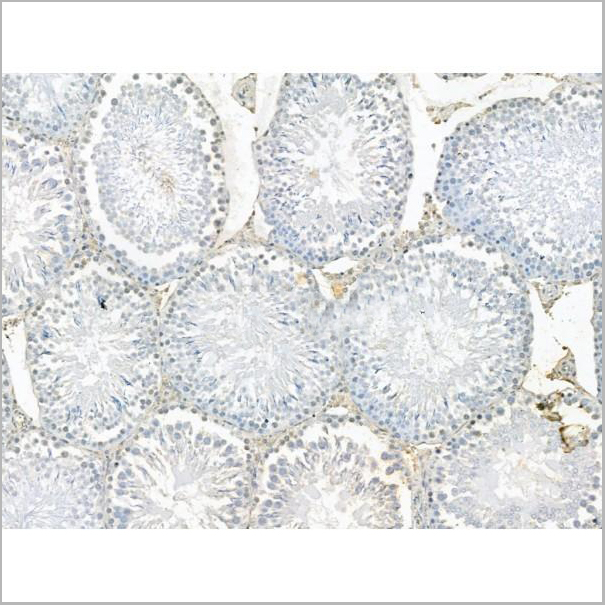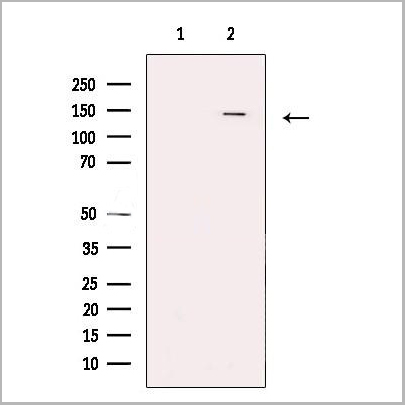Rabbit KMT1E/SETDB1 Polyclonal Antibody | anti-SETDB1 antibody
KMT1E/SETDB1 Antibody
Predicted Reactivity: Bovine(100%), Horse(100%), Sheep(100%), Rabbit(100%), Dog(100%), Chicken(86%), Xenopus(86%)
Predicted Reactivity: Bovine(100%), Horse(100%), Sheep(100%), Rabbit(100%), Dog(100%), Chicken(86%), Xenopus(86%)
IHC: 1:50-1:200
ELISA(peptide): 1:20,000-1:40,000
IHC (Immunohistochemistry-Paraffin)
(AAA31191 at 1/100 staining Human kidney cancer by IHC-P. The sample was formaldehyde fixed and a heat mediated antigen retrieval step in citrate buffer was performed. The sample was then blocked and incubated with the primary antibody at 4°C overnight. An HRP conjugated anti-Rabbit antibody was used as the secondary antibody.)
IHC (Immunohistchemistry-Paraffin)
(AAA31191 at 1/100 staining Mouse brain tissue by IHC-P. The sample was formaldehyde fixed and a heat mediated antigen retrieval step in citrate buffer was performed. The sample was then blocked and incubated with the primary antibody at 4°C overnight. An HRP conjugated anti-Rabbit antibody was used as the secondary antibody.)
IHC (Immunohistochemistry-Paraffin)
(AAA31191 at 1/100 staining Mouse testis tissue by IHC-P. The sample was formaldehyde fixed and a heat mediated antigen retrieval step in citrate buffer was performed. The sample was then blocked and incubated with the primary antibody at 4°C overnight. An HRP conjugated anti-Rabbit antibody was used as the secondary antibody.)
IHC (Immunohistochemistry-Paraffin)
(AAA31191 at 1/100 staining Rat kidney tissue by IHC-P. The sample was formaldehyde fixed and a heat mediated antigen retrieval step in citrate buffer was performed. The sample was then blocked and incubated with the primary antibody at 4°C overnight. An HRP conjugated anti-Rabbit antibody was used as the secondary antibody.)
IHC (Immunohistochemistry-Paraffin)
(AAA31191 at 1/100 staining Rat brain tissue by IHC-P. The sample was formaldehyde fixed and a heat mediated antigen retrieval step in citrate buffer was performed. The sample was then blocked and incubated with the primary antibody at 4°C overnight. An HRP conjugated anti-Rabbit antibody was used as the secondary antibody.)
IHC (Immunohistochemistry-Paraffin)
(AAA31191 at 1/100 staining Rat testis tissue by IHC-P. The sample was formaldehyde fixed and a heat mediated antigen retrieval step in citrate buffer was performed. The sample was then blocked and incubated with the primary antibody at 4°C overnight. An HRP conjugated anti-Rabbit antibody was used as the secondary antibody.)
WB (Western Blot)
(Western blot analysis of extracts from 293T, using KMT1E / SETDB1 Antibody. The lane on the left was treated with blocking peptide.)
Post Translational Modifications: Degraded by the proteasome, shielded by interaction with ATF7IP.
Subcellular Location: Nucleus. Cytoplasm. Chromosome. Note: Associated with non-pericentromeric regions of chromatin. Excluded from nucleoli and islands of condensed chromatin.
Tissue Specificity: Widely expressed. High expression in testis.
Subunit Structure: Part of a complex containing at least CDYL, REST, WIZ, SETDB1, EHMT1 and EHMT2 (PubMed:19061646). During DNA replication, it is recruited by SETDB1 to form a S phase-specific complex that facilitates methylation of H3 'Lys-9' during replication-coupled chromatin assembly and is at least composed of the CAF-1 subunit CHAF1A, MBD1 and SETDB1 (PubMed:15327775). Probably part of a corepressor complex containing ZNF304, TRIM28, SETDB1 and DNMT1 (PubMed:24623306). Interacts with TRIM28/TIF1B (PubMed:11959841). Interacts with ATF7IP and ATF7IP2; the interaction with ATF7IP protects SETDB1 from proteasomal degradation and is required to stimulate histone methyltransferase activity and facilitate the conversion of dimethylated to trimethylated H3 'Lys-9' (PubMed:14536086, PubMed:15691849). Interacts with MBD1; interaction is abolished when MBD1 is sumoylated (PubMed:15327775, PubMed:17066076). Interacts with CBX1 and CBX5 (PubMed:15899859). Interacts with DNMT3A and DNMT3B (PubMed:16682412). Interacts with SUMO2. Interacts with CHD7, NLK1 and PPARG (PubMed:17952062). Interacts with MPHOSPH8 (PubMed:20871592). Interacts with ERG (By similarity). Interacts with HDAC1, HDAC2, SIN3A and SIN3B (By similarity). Interacts with ATRX. Forms a complex with ATRX, TRIM28 and ZNF274 (PubMed:27029610). Interacts with RESF1 (By similarity). Interacts with ZNF638 (PubMed:30487602).
Similarity: The pre-SET, SET and post-SET domains are all required for methyltransferase activity. The 347-amino-acid insertion in the SET domain has no effect on the catalytic activity.Isoform 2 lacks all domains required for histone methyltransferase activity.In the pre-SET domain, Cys residues bind 3 zinc ions that are arranged in a triangular cluster; some of these Cys residues contribute to the binding of two zinc ions within the cluster.Belongs to the class V-like SAM-binding methyltransferase superfamily. Histone-lysine methyltransferase family. Suvar3-9 subfamily.
NCBI and Uniprot Product Information
Predicted Molecular Weight: (Calculated)143kDa.
Similar Products
Product Notes
The SETDB1 setdb1 (Catalog #AAA31191) is an Antibody produced from Rabbit and is intended for research purposes only. The product is available for immediate purchase. The KMT1E/SETDB1 Antibody reacts with Human, Mouse, Rat Predicted Reactivity: Bovine(100%), Horse(100%), Sheep(100%), Rabbit(100%), Dog(100%), Chicken(86%), Xenopus(86%) and may cross-react with other species as described in the data sheet. AAA Biotech's KMT1E/SETDB1 can be used in a range of immunoassay formats including, but not limited to, ELISA (EIA). WB: 1:500-1:2000 IHC: 1:50-1:200 ELISA(peptide): 1:20,000-1:40,000. Researchers should empirically determine the suitability of the SETDB1 setdb1 for an application not listed in the data sheet. Researchers commonly develop new applications and it is an integral, important part of the investigative research process. It is sometimes possible for the material contained within the vial of "KMT1E/SETDB1, Polyclonal Antibody" to become dispersed throughout the inside of the vial, particularly around the seal of said vial, during shipment and storage. We always suggest centrifuging these vials to consolidate all of the liquid away from the lid and to the bottom of the vial prior to opening. Please be advised that certain products may require dry ice for shipping and that, if this is the case, an additional dry ice fee may also be required.Precautions
All products in the AAA Biotech catalog are strictly for research-use only, and are absolutely not suitable for use in any sort of medical, therapeutic, prophylactic, in-vivo, or diagnostic capacity. By purchasing a product from AAA Biotech, you are explicitly certifying that said products will be properly tested and used in line with industry standard. AAA Biotech and its authorized distribution partners reserve the right to refuse to fulfill any order if we have any indication that a purchaser may be intending to use a product outside of our accepted criteria.Disclaimer
Though we do strive to guarantee the information represented in this datasheet, AAA Biotech cannot be held responsible for any oversights or imprecisions. AAA Biotech reserves the right to adjust any aspect of this datasheet at any time and without notice. It is the responsibility of the customer to inform AAA Biotech of any product performance issues observed or experienced within 30 days of receipt of said product. To see additional details on this or any of our other policies, please see our Terms & Conditions page.Item has been added to Shopping Cart
If you are ready to order, navigate to Shopping Cart and get ready to checkout.


